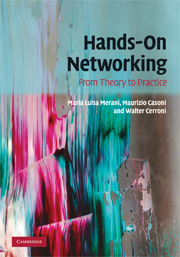5 - LAN devices and virtual LANs
Published online by Cambridge University Press: 05 June 2012
Summary
In the previous chapters the most popular solutions for wired and wireless local area networks have been presented. Signal propagation impairments, on one side, and the multiple access technique adopted by the MAC, on the other, contribute to limit both the maximum distance that a LAN is capable of covering and its achievable performance.
However, the need to deploy LANs spanning larger areas, like an entire enterprise or university campus, has pushed toward the implementation of specific devices that allow these limits to be circumvented: repeaters, bridges and switches [65]. Such devices are also used to implement high-performance and flexible cabling schemes, according to the most up-to-date standard requirements.
This chapter describes these commonly used LAN devices, and then discusses a widely accepted solution for traffic isolation using virtual LANs. The chapter ends with a few practical examples of LAN device management and virtual LAN configuration.
Repeaters and bridges
It has already been mentioned that signal quality degrades with distance, so that a maximum span exists, beyond which a receiver cannot correctly recover the associated information.
This constraint can be bypassed using a repeater, an active device that links two or more LAN segments, with the goal of extending the physical connection between two LAN stations. A repeater amplifies a signal received on any input port and repeats it to all output ports. A repeater decodes incoming bit streams, re-encodes and resynchro-nizes them before retransmission. A repeater can then be classified as a layer-1 device. Regarding the synchronism regeneration, a repeater achieves it either by buffering part of the frame and then adding a delay, or by cutting some header bits for the time required to get resynchronized.
- Type
- Chapter
- Information
- Hands-On NetworkingFrom Theory to Practice, pp. 136 - 160Publisher: Cambridge University PressPrint publication year: 2009



